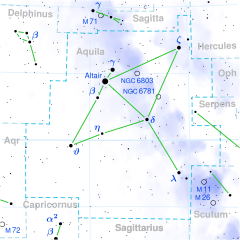| Observation data Epoch J2000 Equinox J2000 | |
|---|---|
| Constellation | Aquila |
| Right ascension | 19h 36m 53.44952s[1] |
| Declination | –7° 01′ 38.9176″[1] |
| Apparent magnitude (V) | +4.957[2] |
| Characteristics | |
| Spectral type | B0.5 III[3] |
| U−B color index | –0.861[2] |
| B−V color index | –0.028[2] |
| Astrometry | |
| Radial velocity (Rv) | –19.4[4] km/s |
| Proper motion (μ) | RA: +1.63[1] mas/yr Dec.: –2.65[1] mas/yr |
| Parallax (π) | 1.94 ± 0.20 mas[1] |
| Distance | approx. 1,700 ly (approx. 520 pc) |
| Absolute magnitude (MV) | −3.60[5] |
| Details | |
| Mass | 15.50 ± 0.61[6] M☉ |
| Radius | 12.5[7] R☉ |
| Luminosity | 52,630[6] L☉ |
| Surface gravity (log g) | 3.5[8] cgs |
| Temperature | 26,500[6] K |
| Metallicity [Fe/H] | −0.16[5] dex |
| Rotational velocity (v sin i) | 265[9] km/s |
| Age | 11.1 ± 0.5[3] Myr |
| Other designations | |
| Database references | |
| SIMBAD | data |
Kappa Aquilae, Latinized from κ Aquilae, is the Bayer designation for a star in the equatorial constellation of Aquila. It is a faint star at apparent visual magnitude +4.957,[2] but bright enough to be seen with the naked eye in dark suburban skies. The annual parallax is only 1.94 mas,[1] which equates to a distance of approximately 1,700 light-years (520 parsecs) from Earth (with a 10% margin of error).
The spectrum of Kappa Aquilae matches a stellar classification of B0.5 III,[3] where the luminosity class of III is typically associated with evolved giant stars. This is a star with 15.50[6] times the Sun's mass and 12.5[7] times the radius of the Sun. Massive stars like this blaze brightly; it is radiating 52,630-fold[6] the Sun's luminosity from its outer atmosphere with an effective temperature of 26,500 K,[6] giving it the intense blue-white glow of a B-type star. It is only 11 million years of age[3] and is spinning rapidly with a projected rotational velocity of 265 km/s.[9]
Etymology
In Chinese, 右旗 (Yòu Qí), meaning Right Flag, refers to an asterism consisting of κ Aquilae, μ Aquilae, σ Aquilae, δ Aquilae, ν Aquilae, 42 Aquilae, ι Aquilae, HD 184701 and 56 Aquilae.[11] Consequently, the Chinese name for κ Aquilae itself is 右旗八 (Yòu Qí bā, English: the Eighth Star of Right Flag.)[12]
This star, together with η Aql, θ Aql, δ Aql, ι Aql and λ Aql were once part of the now-obsolete constellation Antinous.[13]
References
- ^ a b c d e f van Leeuwen, F. (November 2007), "Validation of the new Hipparcos reduction", Astronomy and Astrophysics, 474 (2): 653–664, arXiv:0708.1752, Bibcode:2007A&A...474..653V, doi:10.1051/0004-6361:20078357, S2CID 18759600.
- ^ a b c d Gutierrez-Moreno, Adelina; et al. (1966), "A System of photometric standards", Publications of the Department of Astronomy University of Chile, 1, Publicaciones Universidad de Chile, Department de Astronomy: 1–17, Bibcode:1966PDAUC...1....1G.
- ^ a b c d Tetzlaff, N.; Neuhäuser, R.; Hohle, M. M. (January 2011), "A catalogue of young runaway Hipparcos stars within 3 kpc from the Sun", Monthly Notices of the Royal Astronomical Society, 410 (1): 190–200, arXiv:1007.4883, Bibcode:2011MNRAS.410..190T, doi:10.1111/j.1365-2966.2010.17434.x, S2CID 118629873.
- ^ Wielen, R.; et al. (1999), "Sixth Catalogue of Fundamental Stars (FK6). Part I. Basic fundamental stars with direct solutions", Veroeffentlichungen des Astronomischen Rechen-Instituts Heidelberg, 35 (35), Astronomisches Rechen-Institut Heidelberg: 1, Bibcode:1999VeARI..35....1W.
- ^ a b Anderson, E.; Francis, Ch. (2012), "XHIP: An extended hipparcos compilation", Astronomy Letters, 38 (5): 331, arXiv:1108.4971, Bibcode:2012AstL...38..331A, doi:10.1134/S1063773712050015, S2CID 119257644.
- ^ a b c d e f Hohle, M. M.; Neuhäuser, R.; Schutz, B. F. (April 2010), "Masses and luminosities of O- and B-type stars and red supergiants", Astronomische Nachrichten, 331 (4): 349, arXiv:1003.2335, Bibcode:2010AN....331..349H, doi:10.1002/asna.200911355, S2CID 111387483.
- ^ a b Underhill, A. B.; et al. (November 1979), "Effective temperatures, angular diameters, distances and linear radii for 160 O and B stars", Monthly Notices of the Royal Astronomical Society, 189 (3): 601–605, Bibcode:1979MNRAS.189..601U, doi:10.1093/mnras/189.3.601.
- ^ Frémat, Y.; et al. (September 2005), "Effects of gravitational darkening on the determination of fundamental parameters in fast-rotating B-type stars", Astronomy and Astrophysics, 440 (1): 305–320, arXiv:astro-ph/0503381, Bibcode:2005A&A...440..305F, doi:10.1051/0004-6361:20042229, S2CID 19016751.
- ^ a b Abt, Helmut A.; Levato, Hugo; Grosso, Monica (July 2002), "Rotational Velocities of B Stars", The Astrophysical Journal, 573 (1): 359–365, Bibcode:2002ApJ...573..359A, doi:10.1086/340590.
- ^ "* kap Aql". SIMBAD. Centre de données astronomiques de Strasbourg. Retrieved 2012-01-13.
- ^ (in Chinese) 中國星座神話, written by 陳久金. Published by 台灣書房出版有限公司, 2005, ISBN 978-986-7332-25-7.
- ^ (in Chinese) AEEA (Activities of Exhibition and Education in Astronomy) 天文教育資訊網 2006 年 7 月 3 日
- ^ Ian Ridpath's Star Tales - Antinous

